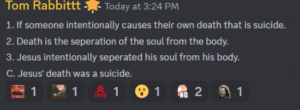Non-Random Genetic Change:
Posted by Jim on September 10, 1998, at 12:43:15:
Hello again! I trust you missed me loads while my laptop wasn’t working.
Anyway, I would have dumped this info on you earlier if I had been able. To recap: I asserted that we saw nonrandom (therefore predictable) genetic changes associated with cancer. As support for this I offer you the following abstracts from the American Society of Hematology meetings the past two years:
1)Frequency and clinical significance of cytogenetic abnormalities in pediatric T-lineage ALL. by Heerema et al: “Nonrandom chromosomal translocations are frequently observed in pediatric patients with ALL.”
2)Selective induction of leukemia-associated fusion genes by high dose ionizing radiation. by Deininger et al: “…Thus high dose irradiation can induce a nonrandom increase in the background level of genetic recombination. This apparent selectivity at the primary level of gene fusion formation may explain in part the increased risk of developing specific forms of leukemia after high dose radiation exposure.”
3)The biased expression of certain VH4 genes is due in part to their preferential rearrangement at the pro-B cell stage. by Rao et al: “…Analysis of 425 clones showed a nonproductive rearrangement frequency of 61%, which is twice as high as the randomly expected frequency of 28%.”
4)Jumping translocations of Chromosome 1q in multiple myeloma: evidence for a mechanism involving decondensation of pericentromeric heterochromatin. by Sawyer et al.: “…We report nonrandom unbalanced whole arm translocations of 1q…”
5)Bcr/abl induces the blastic transformation of p53-deficient bone marrow cells. Nieborowska-Skorska et al.: “Blastic transformation of CML is characterized by the presence of nonrandom, secondary genetic abnormalities in the majority of Ph1+ clones…”
And many more…
I think this makes my point: Genetic changes occur in nonrandom ways dependant on external stimuli(1-5). That we can predict that exposure to specific stimuli will lead to specific disease responses(2, 5). Gene rearrangement occurs in a nonrandom way(all, especially#3). Nonrandom changes put in question the authenticity of evolution since that is what evolutionists hang their hat on.
First Response
Posted by Scott on September 11, 1998, at 11:07:06:
Science 1991 Oct 25;254(5031):554-558
Gene trees and the origins of inbred strains of mice.
Atchley WR, Fitch WM
Department of Genetics, North Carolina State University, Raleigh 27695.
Extensive data on genetic divergence among 24 inbred strains of mice provide an opportunity to examine the concordance of gene trees and species trees, especially whether structured subsamples of loci give congruent estimates of phylogenetic relationships. Phylogenetic analyses of 144 separate loci reproduce almost exactly the known genealogical relationships among these 24 strains. Partitioning these loci into structured subsets representing loci coding for proteins, the immune system, and endogenous viruses give incongruent phylogenetic results. The gene tree based on protein loci provides an accurate picture of the genealogical relationships among strains; however, gene trees based upon immune and viral data show significant deviations from known genealogical affinities.
Response to Scott
Posted by Jim on September 11, 1998, at 11:42:30:
Actually I had read this abstract.
“The gene tree based on protein loci provides an accurate picture of the genealogical relationships among strains; however, gene trees based upon immune and viral data show significant deviations from known genealogical affinities. “
My point concurs with this. Not all the objective data would lead one to conclude that two individuals were related in the correct way.
In this case, it is the genetic data that correspond closer to reality. This is one nicely controlled study in isolated populations. It uses isolated inbred strains but still, the genetic analysis does not reproduce the exact know relationship but only “almost exact”. We should be wary of using genetic similarity to redefine taxonomy when even in controlled conditions of the lab it is unable to reconstruct the relational tree with complete accuracy.
The problem comes when we have been classifying organisms morphologically and then switch suddenly to classifying them genetically. There seems to be a lot of room for error in both methods.
Response to Jim
Posted by Scott on September 11, 1998, at 17:32:12:
“The gene tree based on protein loci provides an accurate picture of the genealogical relationships among strains; however, gene trees based upon immune and viral data show significant deviations from known genealogical affinities. ”
My point concurs with this. Not all the objective data would lead one to conclude that two individuals were related in the correct way.
**** That is why protein-coding or intergenic/intronic sequence data is favored over immune and endogenous viral loci for determining phylogenies.
In this case, it is the genetic data that correspond closer to reality. This is one nicely controlled study in isolated populations. It uses isolated inbred strains but still, the genetic analysis does not reproduce the exact know relationship but only “almost exact”. We should be wary of using genetic similarity to redefine taxonomy when even in controlled conditions of the lab it is unable to reconstruct the relational tree with complete accuracy.
***** The phylogenetic trees generated using the protein-coding loci produced two trees, one of which was the correct one, one that differed only in the branching placement of one strain. That’s a pretty good track record. I guess since not all people respond to chemotherapy, we should not use it at all, eh?
The problem comes when we have been classifying organisms morphologically and then switch suddenly to classifying them genetically. There seems to be a lot of room for error in both methods.
**** When both methods produce results that are congruent, what then? That is, after all, the norm. When two distinct methodologies produce nearly identical results, is that not a good indication that we’re on to something?
You might want to get a hold of the paper and read it in its entirety. There’s another one by Hillis et al. in 92 that gives similar results using mutated viruses.
Second Response
Posted by Paul Rothberg on September 10, 1998, at 15:03:02:
Your post has no meaning. You did a search for the word non-random and came up with some abstracts. As I explained to you before when the endpoint is cancer the genetic changes that contribute to neoplastic change will be seen. That is certainly non-random. That is very different from proposing that changes happen for the purpose of causing cancer. That attributes malevolent intent on DNA, which in the end is just a chemical.
Response to Paul
Posted by Jim on September 10, 1998, at 15:16:54:
That attributes design or malevolent intent on DNA, which in the end is just a chemical.
The point was not that if you look for cancer you will find the genes. Although that is certainly true. The point was that there is a preferential rearrangement of genes which leads to their expression over other genes(as in the Rao paper). Also that we can predict certain mutations based on a known stimulus(as in Deininger). Both of these had been disputed.
Response to Jim
Posted by Paul Rothberg on September 10, 1998, at 17:51:16:
Jim, you miss the point (my point and the point of the abstracts). This is not stimulus and response. Mutagens produce many many mutations. The one we identify in cancers are the ones that are biologically active. The others that do not produce transformation are not reported (most of the time) because they are less interesting. They are also in a smaller proportion of the cells because they do not produce neoplasia.
Response to Paul
Posted by Jim on September 11, 1998, at 11:16:26:
It was asserted that no genetic changes are nonrandom. That all recombinatory events were random events. The point is made that these events DO occur. The one abstract showed that in cases where we would expect random occurrence of the genes they were developed in a nonrandom fashion.
I also pointed out that we can predict genetic changes when we know the stimulus. This was violently refuted at the time(was it you that asked proof of just one instance?). Now I see that you don’t dispute it except to say I’ve proved nothing. You are running away now that your bluff didn’t work. This nonrandom assortment is also seen in birth defects. We see a marked increase in Downs babies in mothers over 40. That was the assertion you still fail to understand.
We also identify many mutations in cancer that have no known function. They are reported quite often as we use them to mark disease progression and to identify the disease. So your assertion that they are not reported is spurious. Unless you meant that outside of oncology these changes aren’t reported or looked for, which I can grant.
You are simply refusing to see my point, or to admit that I’ve corrected an error of understanding amongst evolutionists on the board: Genetic change can be predictable and does occur in nonrandom ways. You can console yourself by saying that it’s only in oncology, but that doesn’t make it any less true.






